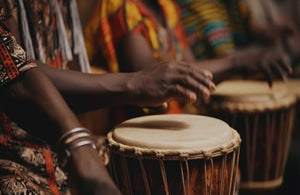8 Facts About Girls' Education in Africa
Despite progress made over the years, gender inequality remains a significant challenge in many African countries, particularly when it comes to education. Even today, millions of young girls in Africa are denied the opportunity to go to school.
We compiled some of the key facts and figures related to girls' education in Africa and explored why investing in it is crucial for the continent's future.
1. In sub-Saharan Africa, 32.6 million girls of primary and lower secondary school age are out of school. This number increases to 52 million when you include girls of upper secondary age. (UNESCO/UIS, 2019)
There are various reasons why girls in Africa often have to drop out of school, including poverty, early marriage, long distances to schools, insecurity due to conflict or violence and cultural practices that prioritize educating boys over girls.
On top of these worrying issues, girls in Africa also face a significant barrier to education that they cannot avoid: their periods. A lack of access to menstrual hygiene products, clean water and/or private toilet facilities can lead to girls missing school during their periods, hindering their education and perpetuating the stigma of menstruation.
2. Across sub-Saharan Africa, 9 million girls between the ages of about 6 and 11 will never set foot in a classroom. (UNESCO, 2022)
This is even higher than the already shocking 6 million boys of this age who miss out on an education. The disadvantage girls suffer starts early, with 23% of girls being out of primary school, compared to 19% of boys. By secondary school, the exclusion rate for girls is 36%, and the rate for boys is 32%.

Access to education is not universal, and unfortunately, girls are often the first ones to be left out. Families living in poverty face the constant challenge of making difficult decisions about how to allocate their extremely limited resources. In many cases, if families can’t afford to send all of their children to school, they prioritize their boys as they are expected to become the bread of the family.
3. One of the worst affected countries is Somalia, where fewer than 2% of girls attend secondary school. (African Educational Trust)
Somalia is home to one of the largest out-of-school populations in the world, with approximately 3 million out of 5 million school-aged children and youth not attending school. The country's educational system has been severely impacted by over two decades of conflict, resulting in poor quality education, an insufficient number of qualified teachers, and limited resources.
Droughts and flooding also displace many children and youth from their homes and disrupt their education.
4. In Kenya, 16% of girls did not resume their studies after the COVID-19 pandemic, compared to 8% of boys. (UNICEF, 2021)
The COVID-19 pandemic exacerbated issues related to girls’ education in Africa. After almost a year of closures, far fewer girls returned to school in 2021.
The pandemic forced many schools in Africa to close, disrupting the education of millions of students. Girls were often disproportionately affected by school closures and economic challenges, as they were more likely to be responsible for household chores and caring for family members.On top of this, the closure of schools increased the likelihood of early marriage and pregnancy for girls, which further hindered their educational opportunities and perpetuates gender inequality.
5. 41.2% of women in sub-Saharan Africa are unable to read or write. (The World Bank, 2019)
This is compared to an already troubling 26% of men in the same region. The discrepancy between male and female literacy in this region showcases the consequences of girls being excluded from education from such a young age.
Women who are not literate have limited access to information, which can hinder their ability to make informed decisions about their health, finances, and other important aspects of their lives. Illiteracy can also limit women's economic opportunities and make them more vulnerable to exploitation and abuse.

However, the literacy rate among women is improving, having increased by 25.6% since 2000, when 53.2% of women in sub-Saharan Africa were not literate. This is largely as a result of initiatives to improve girls’ education in Africa, such as by providing funding for schools, promoting awareness, working to change cultural attitudes towards girls' education and promoting gender equality in all aspects of life.
6. Women with an education will reinvest 90% of their earnings back into the families, compared to just 35% of men. (Clinton Global Initiative)
This statistic highlights the transformative impact improving girls’ education in Africa can have not just on their own lives, but also on their family’s and community. When women are educated, they are more likely to earn an income and have greater decision-making power within their households.
Research has shown that women tend to prioritize the needs of their families when it comes to spending their earnings, reinvesting a significant portion back into areas such as healthcare, education, and nutrition. This can have a ripple effect in promoting the wellbeing and development of future generations.
7. Educated girls are up to 3x less likely to become HIV-positive, and they’re at a reduced risk of malaria. (UN AIDS Gap Report 2014)
Education plays an important role in promoting girls' and womens’ health, allowing them to gain knowledge that can help them make informed decisions about their health, and protect themselves from diseases like HIV and malaria.
Additionally, education can help to empower girls and give them greater control over their lives, reducing their vulnerability to factors such as gender-based violence that may pose a threat to their health.
8. Girls with secondary schooling are 5x less likely to marry as children, compared to girls who have little or no education. (Global Partnership for Education, 2019)
Access to education plays a crucial role in ensuring the safety of girls, as those who are out of school are much more vulnerable to issues such as child marriage, early pregnancy, and forced labor.

When girls have access to secondary education, they are empowered with knowledge and skills that can help them make informed decisions about their lives, including when and whom to marry.
Child marriage can have serious negative consequences for girls' health, wellbeing, and future opportunities. It often forces them out of school and into early motherhood, perpetuating cycles of poverty and limiting their potential.
Investing in girls' education in Africa, and promoting policies that keep girls in school, can help to break these harmful cycles and empower girls to reach their full potential. At Mayekoo, we’re committed to shining a light on the troubling realities facing the young women of Africa, and to changing the systems that deny them access to education as well as the opportunities to reach their potential.


